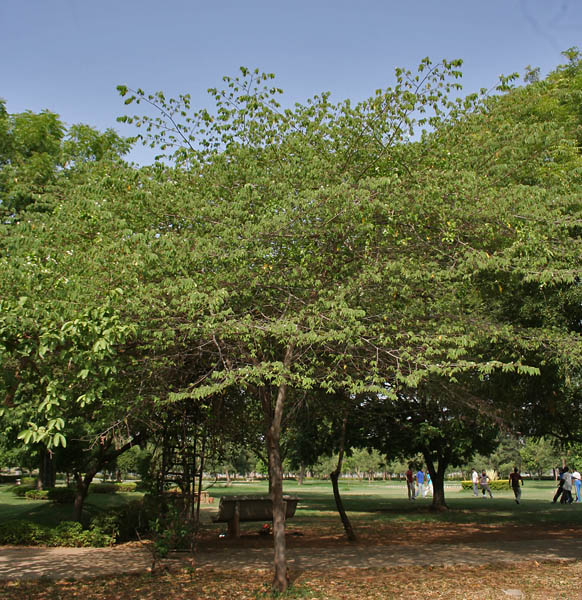In front of the house where I grew up was an unkempt lot in which a ~5 meter tall tree once stood among the weeds and grass. It had a smooth, whitish trunk while its branches sprout outward from the top like a parasol. Once a year the tree becomes dotted with small white flowers akin to the famous cherry blossoms of Japan—and just like their Japanese counterpart, their white petals get carried away easily by the wind too. These flowers turn into small, green fruits which are as hard as a pebble. After a few days, these green fruits turn into red and succulent “cherries” which make the whole tree look like a Christmas tree with tiny red baubles.

For English speakers, that tree is known as the Calabur Tree or Jamaica Cherry Tree. Here in the Philippines, it is widely known as aratilis, aratiles, datiles depending on what your dialect is. It’s quite hard to pronounce the l and the r, thats why we (and by “we”, I mean the children in our neighborhood exclusively) call it as alatiris. In the binomial system, it is known as Muntingia calabura. Even though it’s from South America, you can find it everywhere here in the Philippines because it already is a naturalized species.
It is a tree that’s in the memories of many Filipinos such as me that lived as a child in a time where technology hasn’t completely taken over everyone’s lives yet. We physically played on the dirt, the grass, the streets, the cliffs and the rivers. My childhood friends and I always gathered under the shade of that aratiles tree in front of our house to pick its crimson fruits. I always pretended that I liked eating those wretched fruits because my friends gobble them whenever it’s available. Yes, they taste sweet and tart-like but dear Lord it’s texture is horrifying! It’s like biting a cyst filled with rough sand or thousands of insect eggs. Disgusting.
Fortunately there are other more likeable uses for the fruit of the aratiles tree. Rather than eating them, we used the fruit in a game where we just throw them to each other. There were no rules, the game will only end if everyone gets exhausted or if someone slipped or got hurt because of running. (Our street has an inclination of about 50° which is why accidents are normal there.) Getting hit by the unripe green fruits really hurt but being hit by the ripe ones is more nasty and messy.
We all climbed trees as children. I’ve climbed this specific tree many times, and many times have I been swarmed by red ants living in its branches. However, in certain times of the year, this tree gets infested with hairy, stinging caterpillars. I remember that a caterpillar once fell on my cousin’s arm. A few minutes later, that cousin of mine was all red, swollen and wailing because of pain. To alleviate the allergic reaction, my cousin was bathed with vinegar and was, therefore, humiliatingly called by me and my friends as a lumpiang togue the whole afternoon. (Lumpiang togue is a Filipino springroll that you dip in vinegar before eating.)
Muntingia calabura trees produce lots of fruits when in-season. Every morning, you’ll see flocks of birds foraging on the red berries. It was fun to watch them especially the Red-keeled Flowerpeckers which I don’t see anywhere nowadays. At evening, the tree attracts other flying creatures. I remember when badminton was a craze in our whole subdivision—at that time, you’ll start to see people playing badminton starting at around 04:00 pm until sunset. The inclined street was our badminton court and our net was a piece of plastic straw that’s tied on gates or electric posts from one side of the street to the other. At sunset, together with the seemingly scheduled calls of Tockay geckoes among the mango trees is the arrival of tiny fruit bats—they literally swarm and swoop above your heads especially when the aratiles tree is full of fruits. Taking advantage of the swarm of fruit bats, my neighborhood friends invented this game called batminton (yes, pun was intended) where we smack bats with badminton racquets. It was relatively easy hitting them but none of us made a fruit bat fall to the ground. These small, chirping fuit bats fly out minutes after sunset; however, when the night is already deep, bigger fruit bats appear in pairs or trios. We didn’t smack them with our racquets though because they’re huge.
That specific tree in an empty lot in front of our house provided me and my childhood friends with shade and plenty of memories. Sadly it was cut down about three years ago because the grassy and unkempt lot in which it was standing was cleared out due to the sudden appearance of snakes in our neighborhood. But just down the street is another aratilis tree which grew from a seed of that felled tree. Muntingia trees are very hard to kill and exterminate, just like memories.
I like aratiles. I used to climb them too, though I know their branches is not that sturdy and can easily break, unlike the bayabas tree. Thank you for sharing your memories about the aratiles. It kindled some of my own.
LikeLike
You’re welcome! To bad kids these days are preoccupied with their gadgets. Oh, how I wish they could experience the fun and simplicity of our childhood then.
LikeLike